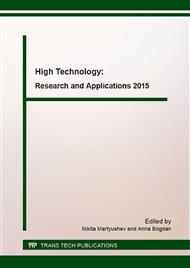[1]
F.M. Khoury, Multistage Separation Processes, Fourth Edition, CRC Press, Boca Raton, FL, (2015).
Google Scholar
[2]
A.A. Khamukhin, E.V. Nikolayev, Modeling of Gas Multistage Separation to Increase Stock Tank Oil, Advanced Materials Research, 1040 (2014) 508–512.
DOI: 10.4028/www.scientific.net/amr.1040.508
Google Scholar
[3]
G. Hestroni, Handbook of Multiphase Systems, Hemisphere Publishing Corp., Washington, DC, (1982).
Google Scholar
[4]
C.T. Crowe, Multiphase Flow Handbook, CRC Press, Boca Raton, FL, (2006).
Google Scholar
[5]
V. A. Arkhipov, I. M. Vasenin, A. S. Usanina, Experimental study of nonstationary regimes of ascent of a single bubbles, J. of Eng. Physics and Thermophysics., 5(86) (2013) 1171–1181.
DOI: 10.1007/s10891-013-0939-3
Google Scholar
[6]
P. Gramme, G.H. Lie, Device for separation of fluid, in particular oil, gas and water, U.S. Patent 8, 012, 347. (2011).
Google Scholar
[7]
B. Nirjhar, K.D. Sudip, Gas-non-Newtonian Liquid Flow through Horizontal Pipe – Gas Holdup and Pressure Drop Prediction using Multilayer Perceptron, American J. of Fluid Dynamics, 2(3) (2012) 7–16.
DOI: 10.5923/j.ajfd.20120203.01
Google Scholar
[8]
E. Niazi, M. Shams, A. Elahi, G. Ahmadi, Simulation of gas–non-Newtonian liquid flow in a rectangular bubble column by considering bubbles interactions, ASME Proceedings, 12th Int. Symp. on Numerical Methods for Multiphase Flow, Puerto Rico, USA, 2102, p.669.
DOI: 10.1115/fedsm2012-72361
Google Scholar
[9]
M.J. Prince, H.W. Blanch, Bubble coalescence and break-up in air-sparged bubble columns, AIChE J., 36(10) (1990) 1485–1499.
DOI: 10.1002/aic.690361004
Google Scholar
[10]
Aspen HYSYS. Upstream Operations Guide. Version Number V7. 3, Burlington, (2011).
Google Scholar
[11]
A.A. Khamukhin, I. Sh. Islyamov, F. Hz. Naymanbaev, Modeling of Single-Phase Flows in Separation Equipment, in Proc. 7th Int. Forum on Strategic Technol. (IFOST2012), Sep. 18–21 2012, Tomsk, Russia. Article number 6357665.
DOI: 10.1109/ifost.2012.6357665
Google Scholar
[12]
A.A. Khamukhin, Web Modeling for Monitoring and Management of Associated Petroleum Gas Separation on Oilfields, in Proc. 8th Int. Forum on Strategic Tech. (IFOST2013), 2013, Ulaanbaatar, Mongolia. 2 (2013) 235-237, Article no 6616893.
DOI: 10.1109/ifost.2013.6616893
Google Scholar


